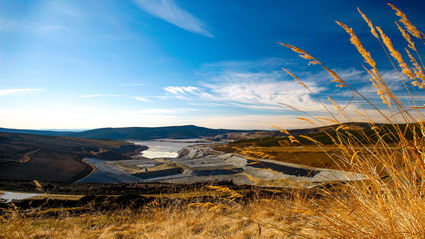Lower gold output new norm for Fort Knox
North of 60 Mining News – February 15, 2019
Last updated 9/25/2020 at 2:03pm

Kinross Gold Corp.
A view looking over the Walter Creek Arctic Heap Leach pad, a facility that has produced more than 1 million ounces of gold at the Kinross' Fort Knox Mine a few miles north of Fairbanks.
Kinross Gold Corp. Feb. 13 reported a nearly 33 percent drop in gold produced at its Fort Knox Mine in Alaska during 2018, when compared to the previous year.
This operation about 25 miles north of Fairbanks produced 255,569 ounces of gold last year, a 132,546 oz drop from the 381,115 oz produced in 2017.
Kinross said this lower gold output is primarily attributed to a minor pit wall slide that occurred in March, which restricted access to higher-grade ore. This problem was compounded by higher than average rainfall in the second half of 2018, which affected geotechnical stability.
Fort Knox produced 52,194 oz of gold during the fourth quarter of 2018, a roughly 45 percent decrease from the 96,715 oz recovered during the same period of 2017.
The per-ounce cost of Fort Knox gold sold during the quarter was US$946, a 52 increase over the US$620 production cost of sales during the final three months of 2017.
The mill processed 2.86 million metric tons of ore averaging 0.44 grams per metric ton gold during the quarter, compared to 4.46 million metric tons averaging 0.96 g/t during the same period of 2017.
Additionally, 2.93 million metric tons of ore averaging 0.19 g/t gold was processed on the heap leach pad during the final quarter of 2018, compared to 4.46 million metric tons averaging 0.23 g/t during the third quarter of 2017.
Kinross said the pit wall slide at Fort Knox is limiting the areas of the pit that can be accessed, which is the reason for the lower grade ore being fed into the mill.
"Fort Knox continued to experience headwinds in the fourth quarter as we work through the challenges associated with the wall slide that occurred early in 2018 and restricted access to the higher-grade material," Kinross Gold COO Lauren Roberts informed shareholders and analysts on Feb. 13.
In order to preserve tailings storage capacity for the highest grade ore, the company is reducing mill throughput until that ore can be reached.
"As a result, we expect production to decrease in Q1 (first quarter 2019) compared to Q4 and then increase as the year progresses," Roberts said.
New Fort Knox
While 2018 gold production at Fort Knox is the lowest since 1996, the year the mine went into production, the year also brought good news for the future of this gold operation.
This good news came in June, when Kinross announced plans to develop Gilmore, an expansion project that is expected to extend the life of the Fort Knox Mine another decade into the 21th Century.
Lying immediately west of the Fort Knox pit, the source of nearly 8 million oz of gold produced at the Interior Alaska operation over the past 23 years, the initial phases of the Gilmore expansion is expected to add at least 1.5 million oz of gold to the tally by 2030.
A feasibility published for the Gilmore expansion last year envisions nearly all of the gold mined from Gilmore will be recovered via heap leaching, a process that involves stacking the ore on a lined pad and using a mildly acidic leaching agent trickled over the ore to dissolve the gold into a solution that is pumped through a facility that recovers the gold.
Kinross has been operating the Walter Creek Arctic Heap Leach facility at Fort Knox for nearly a decade, demonstrating the viability of this gold recovery technique in cold climates. This facility has been producing more than 100,00 oz of gold annually and crossed the 1 million oz threshold in 2018.
Over that time, lower grade ore from the Fort Knox pit was stacked on the heap leach pad and the higher grade material was processed through the mill.
The mill at Fort Knox, however, is currently slated to be phased out by the end of 2020, according to the Gilmore project feasibility study.
To accommodate the ore mined from Gilmore, Kinross has begun early construction work on the Barnes Creek Heap Leach Pad.
Kinross Chief Technical Officer Paul Tomory said this work is off to a good start.
"We have completed final engineering at the Barnes Creek heap leach pad, grading for the new pad was complete in the fourth quarter and we expect construction activities to ramp up in the spring and continue through 2020," he informed investors and analysts on Feb. 13.
Initial production from Gilmore is slated for early 2020.
During the Feb. 7 Alaska Resources Development Council breakfast in Anchorage, Fort Knox General Manager Jeremy Brans said the gold production seen in 2018 will be the new norm for the mine as it transitions to producing the bulk of its gold from the new heap leach pad.
"This is going to be a bit of a transition for Fort Knox – we used to produce about 365,000 oz (gold) a year; going forward, it's going to be about 250,000 oz a year," he said.
Kinross management views these initial phases of the Gilmore project as a bridge to further extensions to the Fort Knox operation.
–SHANE LASLEY
CORRECTION: This article has been updated to correctly state the date the first quarter results were reported by Kinross Gold Corp.













Reader Comments(0)